It is Christmas time and my 10-year-old son Arian wanted to wear a Santa hat to school. On the busy Monday morning, he put it on his head and we were ready to leave home. As always, we were late and we were in rush. However, I wanted to take a photo of him in the hat! I didn't have much time to take out my camera. If I tried that, he would be late to school, or he would have walked out of the home. As we say, the best camera is the one that is with you. I had my cell phone Samsung Note 4 with me. I turned it on, told my son where to stand and I quickly took 3 shots! Why not only 1? In case if eyes are closed or the face has weird expressions, I can discard those problem photos. Also having 3 photos would let me choose a better photo.
It was a sunny morning. The room had some parts very dark as curtains were still rolled down. However, near the backyard door, it was filled with morning sunlight. It was a very high dynamic range situation. As we generally try to take photos in shadows to eliminate over-or under-exposing associated with HDR (High Dynamic Range) associated with direct bright sunlight, I was thinking to take photos inside the home but in a spur of the moment, to get nice bright colors in the beautiful morning light, I had him stand such a way that the background would come darker. On the screen, I touched and held the area around his face. This way I told the phone camera to meter off of his face and ignore the total light in the frame. This 10 seconds shoot-out worked perfectly!
So some quick lessons:
1) There is no hard and fast rule to avoid direct sunlight! Like all other rules in photography, this rule can be broken too!
2) You really do not need expensive cameras in all situations. There are times when a phone camera would do as good as an expensive full-frame camera!
It was a sunny morning. The room had some parts very dark as curtains were still rolled down. However, near the backyard door, it was filled with morning sunlight. It was a very high dynamic range situation. As we generally try to take photos in shadows to eliminate over-or under-exposing associated with HDR (High Dynamic Range) associated with direct bright sunlight, I was thinking to take photos inside the home but in a spur of the moment, to get nice bright colors in the beautiful morning light, I had him stand such a way that the background would come darker. On the screen, I touched and held the area around his face. This way I told the phone camera to meter off of his face and ignore the total light in the frame. This 10 seconds shoot-out worked perfectly!
 |
| Arian Patel |
1) There is no hard and fast rule to avoid direct sunlight! Like all other rules in photography, this rule can be broken too!
2) You really do not need expensive cameras in all situations. There are times when a phone camera would do as good as an expensive full-frame camera!




































